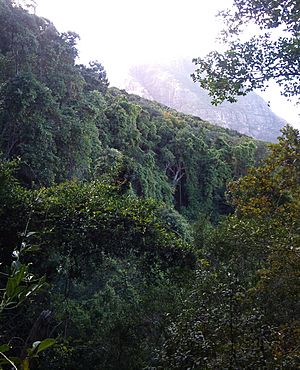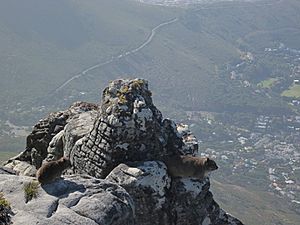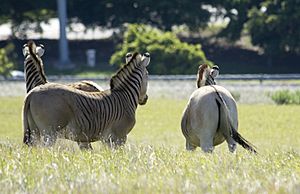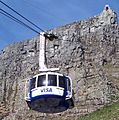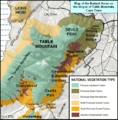Table Mountain facts for kids
Quick facts for kids Table Mountain (Huriǂoaxa) |
|
|---|---|
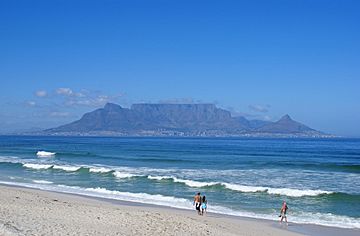
View of Table Mountain and Cape Town seen from Bloubergstrand. Table Mountain is flanked by Devil's Peak on the left and Lion's Head on the right.
|
|
| Highest point | |
| Elevation | 1,084.6 m (3,558 ft) |
| Prominence | 1,055 m (3,461 ft) |
| Geography | |
| Location | Cape Town, South Africa |
| Geology | |
| Age of rock | Silurian/Ordovician |
| Mountain type | Sandstone |
| Climbing | |
| First ascent | António de Saldanha, 1503 |
| Easiest route | Platteklip Gorge |
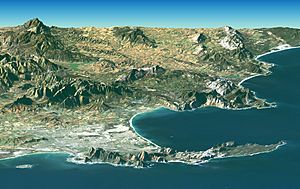
Table Mountain is a famous flat-topped mountain in South Africa. It stands tall above the city of Cape Town. The mountain is about 1,085 meters (3,560 feet) high. It looks like a giant table!
Table Mountain is a very popular place for tourists to visit. It even appears on the flag of Cape Town. Many people ride the Table Mountain Aerial Cableway to the top. Others enjoy hiking up its trails. This amazing mountain is part of the Table Mountain National Park.
Contents
How Table Mountain Was Formed
The top part of Table Mountain is made of a very strong rock called sandstone. This sandstone formed a long, long time ago, during the Silurian and Ordovician periods. It is very tough and does not wear away easily. This is why the mountain has its steep, grey cliffs.
Below this sandstone, there is a softer rock called shale. This shale wears away more easily. The very bottom of the mountain is made of older metamorphic rocks and granite. These rocks are from the late Precambrian age.
Amazing Plants of Table Mountain
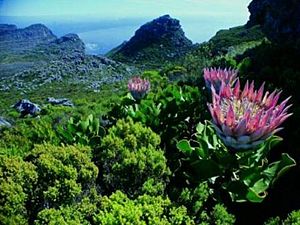
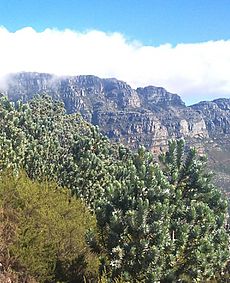
Table Mountain has an incredible variety of plants. It is home to many types of a special plant group called fynbos. Fynbos plants are unique to the Cape region. Some types of fynbos found here are very rare and in danger of disappearing.
The plants on Table Mountain are part of the Cape Floristic Region. This area is so special that it is a World Heritage Site. Experts believe that about 2,285 different plant species live only on Table Mountain and the nearby Cape Peninsula. Many of these plants, including beautiful proteas, cannot be found anywhere else in the world.
One special flower is the Disa uniflora, also known as the Pride of Table Mountain. This bright orchid blooms from January to March. You can often see it near waterfalls and streams on the mountain.
Forests and Fires
Some parts of Table Mountain still have patches of natural forest. However, early European settlers cut down many trees for fuel. Today, efforts are being made to protect and restore these forests.
Fynbos plants need fires to stay healthy. Fires help new plants grow and keep the plant types diverse. People have been using fire in this area for thousands of years. This was often done to help with hunting or to create fresh grazing land for animals. So, the plants on Table Mountain are used to fires.
However, fires must not happen too often or be too strong. If fires happen too frequently, some rare plants can be wiped out. Today, most fires on the mountain are caused by people.
Protecting the Plants
Despite efforts to protect them, Table Mountain has the highest number of threatened species of any similar-sized area in the world. Many invasive species (plants that are not native to the area) have also spread on the mountain. These include certain types of pine trees and Australian acacia plants. Workers are trying hard to remove these invasive plants to help the native fynbos grow.
Animals of Table Mountain
Mammals and Birds
The most common mammal on Table Mountain used to be the dassie (also called rock hyrax). These small, furry animals look a bit like large guinea pigs. Sadly, their numbers dropped a lot between 2000 and 2004.
The decline in dassies also affected the Verreaux's eagles. These large eagles hunt dassies. In 2004, there were only two pairs of these eagles left on the Cape Peninsula. One pair lived near the cable station, but they left in 2006. The other pair lived near Noordhoek Peak. In early 2017, a pair of eagles was seen again, giving hope for their future.
Table Mountain is also home to porcupines, mongooses, snakes, lizards, and tortoises. A very rare frog, the Table Mountain ghost frog, lives only on Table Mountain.
Long ago, lions and leopards lived here, but they are now gone from the area. Two smaller, shy wild cats, the rooikat (caracal) and the vaalboskat (Southern African wildcat), were once common. The caracal is still sometimes seen by hikers.
The mountain cliffs are a home for several types of birds of prey. These include the jackal buzzard, booted eagle, African harrier-hawk, peregrine falcon, and rock kestrel. African fish eagles also live on the Peninsula, but they prefer to nest in trees far from people.
Baboons and Other Animals
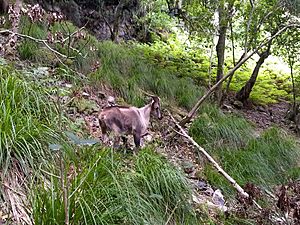
Until the late 1990s, baboons lived all over the mountains, including Table Mountain itself. Now, they mostly live south of Constantia Nek. They often come down to the lower slopes, which brings them close to Cape Town's suburbs. This can cause problems with people and traffic.
To help the baboons, monitors armed with paint ball guns now stay with the baboon troops all day. They try to stop the baboons from going into the suburbs. Since this program started in 2009, the number of baboons on the Peninsula has grown. Fewer baboons are also being hurt by people or cars.
You might also see Himalayan tahrs on the mountain. These are wild goats that escaped from a zoo in 1936. They are not native to South Africa. Efforts are being made to remove them so that native animals like klipspringers can return. There were also some fallow deer and sambar deer (types of deer) in the past, but they are also being removed.
The Quagga Project
On the slopes of Devil's Peak, there is an animal camp. This camp is part of the Quagga Project. The quagga was a type of zebra that used to live in South Africa. It was hunted until it became extinct in the 1800s. The last quagga died in a zoo in 1883.
In 1987, a project started to "back-breed" the quagga. Scientists found that quaggas were closely related to plains zebras. They are trying to breed zebras that look like quaggas. These new zebras are called Rau quaggas. You can see some of these quagga-like zebras in the animal camp, but it is not open to the public.
Images for kids
-
Table Mountain from Capt. Cook's ship HMS Resolution by William Hodges (1772).
-
The cable car with Robben Island in the background.
-
Cape Town, Signal Hill, Table Bay and Robben Island as seen from the upper cable station of the Table Mountain Cableway.
-
Table Mountain and Cape Town seen from Bloubergstrand.
-
Cape Town's beach, the Atlantic Ocean, and Table Mountain.
See also
 In Spanish: Montaña de la Mesa para niños
In Spanish: Montaña de la Mesa para niños



